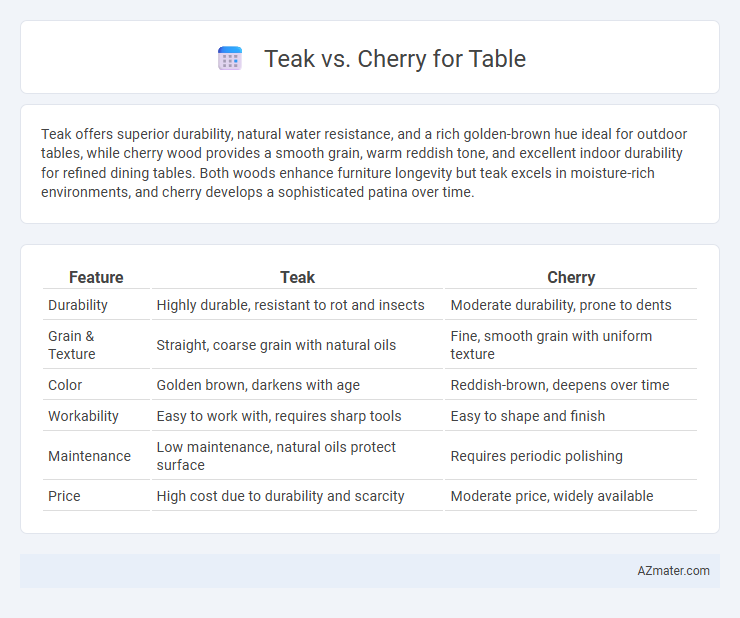Teak offers superior durability, natural water resistance, and a rich golden-brown hue ideal for outdoor tables, while cherry wood provides a smooth grain, warm reddish tone, and excellent indoor durability for refined dining tables. Both woods enhance furniture longevity but teak excels in moisture-rich environments, and cherry develops a sophisticated patina over time.
Table of Comparison
| Feature | Teak | Cherry |
|---|---|---|
| Durability | Highly durable, resistant to rot and insects | Moderate durability, prone to dents |
| Grain & Texture | Straight, coarse grain with natural oils | Fine, smooth grain with uniform texture |
| Color | Golden brown, darkens with age | Reddish-brown, deepens over time |
| Workability | Easy to work with, requires sharp tools | Easy to shape and finish |
| Maintenance | Low maintenance, natural oils protect surface | Requires periodic polishing |
| Price | High cost due to durability and scarcity | Moderate price, widely available |
Introduction to Teak and Cherry as Table Materials
Teak and cherry are premier hardwoods widely used in table construction, valued for their durability and distinctive aesthetics. Teak boasts exceptional resistance to moisture and insects due to its natural oils, making it ideal for both indoor and outdoor tables, while cherry delivers a warm, rich tone that deepens beautifully with age, enhancing indoor settings. Both woods offer strong structural integrity, but teak's resilience suits high-traffic areas, whereas cherry is preferred for elegant, refined furniture pieces.
Teak Wood: Key Characteristics and Benefits
Teak wood is renowned for its exceptional durability, natural resistance to moisture, and rich golden-brown hue that deepens with age, making it ideal for table construction. Its dense grain and high oil content protect against rot, insects, and warping, ensuring long-lasting performance even in humid environments. The ease of maintenance and timeless aesthetic appeal of teak wood significantly enhance the value and functionality of tables compared to cherry wood.
Cherry Wood: Unique Qualities and Advantages
Cherry wood offers a warm, rich reddish-brown hue that deepens over time, enhancing the natural beauty of tables with its elegant aging process. Its fine, straight grain and smooth texture contribute to a refined finish, making it highly desirable for handcrafted furniture. Known for its durability and resistance to warping, cherry wood provides a sturdy yet sophisticated option for long-lasting tabletops.
Appearance and Grain Comparison: Teak vs Cherry
Teak wood showcases a warm golden-brown hue with a coarse, straight grain that often features natural oily texture, making it highly resistant to moisture and ideal for outdoor tables. Cherry wood presents a rich reddish-brown color that deepens over time, with a fine, smooth grain pattern often highlighted by subtle curls or waves, delivering a more refined and elegant look. The contrast in grain texture and color between teak and cherry significantly influences the aesthetic choice for table design, balancing durability with visual warmth.
Durability and Longevity of Teak vs Cherry Tables
Teak tables offer exceptional durability due to their high natural oil content, making them highly resistant to moisture, insects, and rot, which ensures longevity even in humid environments. Cherry tables, while known for their beautiful aging process and smooth texture, are softer and more prone to dents and scratches, requiring more careful maintenance to preserve their appearance over time. Overall, teak surpasses cherry in durability and longevity, making it a superior choice for long-lasting furniture in both indoor and outdoor settings.
Maintenance Requirements: Teak and Cherry
Teak requires minimal maintenance due to its natural oils that resist water, rot, and insects, making it ideal for outdoor tables with occasional cleaning and oiling to preserve its golden hue. Cherry wood demands more care, including regular polishing and protection from direct sunlight to avoid discoloration and surface damage, as it is prone to scratches and fading. Both woods benefit from controlled indoor environments to extend their lifespan, but teak's durability offers lower overall upkeep compared to cherry.
Cost Analysis: Teak vs Cherry Tables
Teak tables typically cost more due to the wood's durability, natural resistance to moisture, and long lifespan, often ranging between $900 and $1,500 for mid-sized pieces. Cherry tables usually fall within the $600 to $1,200 range, offering a rich, warm finish but requiring more maintenance and potential refinishing over time. The cost-effectiveness of teak emerges over years of minimal upkeep and resilience, while cherry provides affordability upfront with possible higher long-term care expenses.
Sustainability and Environmental Impact
Teak wood is highly valued for its durability and natural resistance to pests, making it a sustainable choice when sourced from responsibly managed plantations certified by FSC or PEFC standards. Cherry wood, while slower growing, is often harvested from native forests, raising concerns about habitat disruption and requiring careful management to ensure environmental sustainability. Both woods benefit from sustainable forestry practices, but teak's faster growth rate and plantation availability generally result in a lower environmental footprint compared to wild-harvested cherry.
Best Uses: When to Choose Teak or Cherry for a Table
Teak is ideal for outdoor tables due to its natural resistance to moisture, decay, and insects, making it perfect for patios and garden settings. Cherry wood, renowned for its smooth texture and rich, warm tones, is best suited for elegant indoor dining tables and fine furniture where a polished, refined look is desired. Choose teak for durability and weather resistance, while cherry excels in indoor environments emphasizing craftsmanship and aesthetic appeal.
Final Verdict: Which Wood is Better for Your Table?
Teak offers exceptional durability, natural resistance to water and pests, and a rich golden hue that deepens with age, making it ideal for outdoor or high-traffic tables. Cherry features a smooth texture and warm reddish-brown color that darkens beautifully over time, providing elegance and a refined finish suited for indoor furniture. Choosing teak is better for longevity and weather resistance, while cherry excels in aesthetic appeal and indoor use.

Infographic: Teak vs Cherry for Table
 azmater.com
azmater.com